
No. 54: EM Use as the National Policy of Thailand for Clean-up After the Massive Flood in 2011
From September to December in 2011, Bangkok area was covered by the worst flood in 100 years in Thailand. Sky in the affected area was clear and blue, but rainfall in the upper stream basin inundated parts, an area wider than Hokkaido, of the capital city of Bangkok. The flood submerged most of the Japanese factories and caused great losses.
Many Japanese businesses were affected by both disasters; the Northeastern Japan earthquake and the flood in Thailand. EM production site near Ayutthaya was also flooded. In Japan, flood is usually caused by heavy rainfall that rushes to the sea, but over within several days. However, in the metropolitan area of Thailand where land spreads almost flat and not high from the sea, rainfall in the upper river basin tends to pool before discharged to the sea and causes flood although no rain falls in the flooded area.
Flood water moved so slow that toilet waste, other waste water, garbage, grease and oil, and various debris were mixed and floated in the water and emitted foul odor. It was extremely unhygienic and caused the symptoms similar to athletes' foot when one stands long time in the water. People were worried if it would cause various communicable diseases.
To manage the situation, Thai government mobilized its armed force and used EM: Royal Thai Army was put in charge to work in cooperation with the Ministry of Science, Technology, and Environment and the Ministry of Social Development and Human Security. EM stocks were relocated to a safe place before submerged in the flood water. However, in order to meet the demand for EM, Royal Thai Army let us use a part of its large storage space to continue full scale EM production.
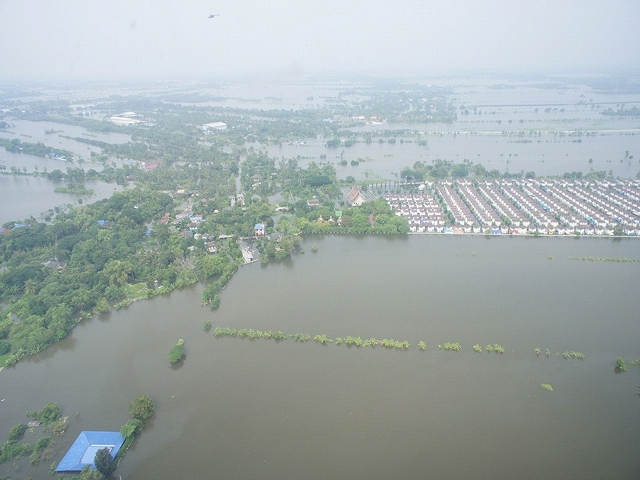
Picture 1
Picture 1: Bangkok suburb in the flood
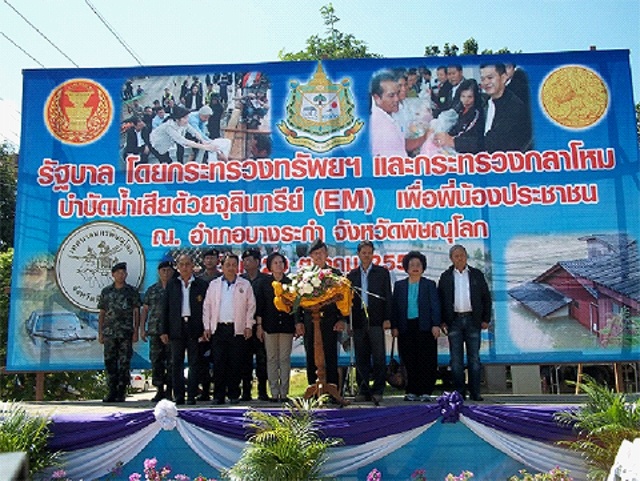
Picture 2
Picture 2: Ceremony to begin disaster control by EM (spelled out in the center of the back screen). One of the logos indicates approval by the King.

Picture 3
Picture 3: EM distribution sites. Upper right picture shows the trade mark of EM Research Organization (EMRO) in green.
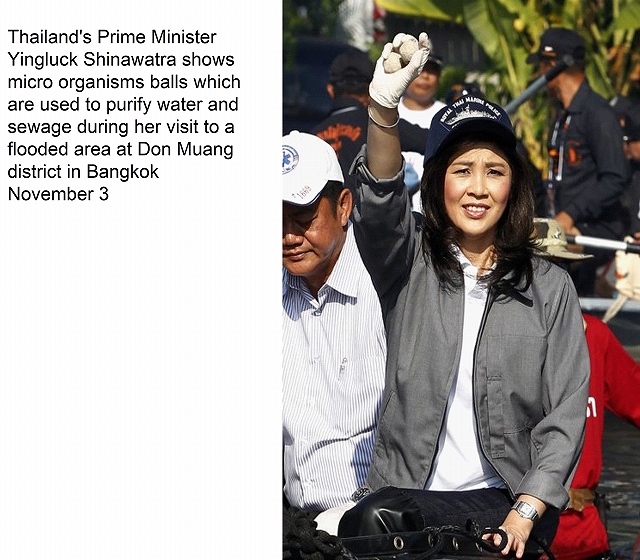
Picture 4
Picture 4: Thailand's Prime Minister Yingluck Shinawatra throws EM ball to launch the project
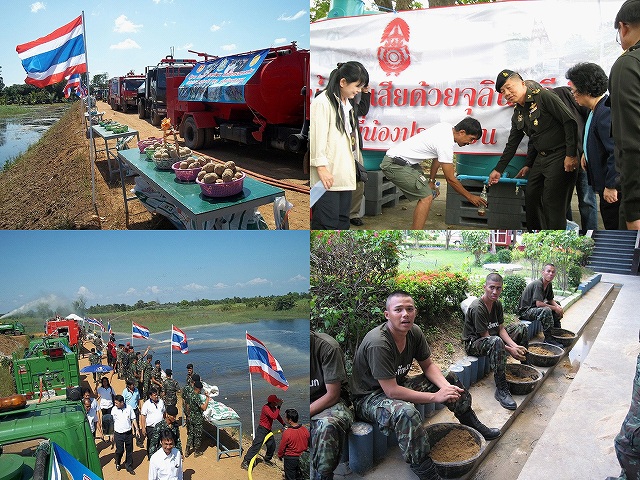
Picture 5
Picture 5: EM activities. Lower right picture shows soldiers making EM balls.

Picture 6
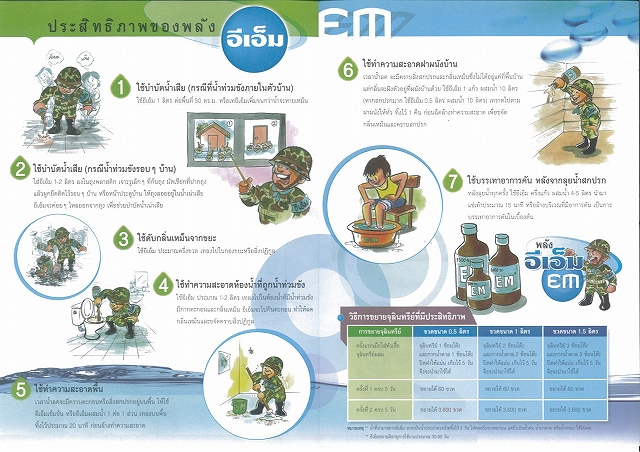
Picture 7
Picture 6-7: Front and back of the leaflet prepared and given out by the Army in order to explain how to use EM
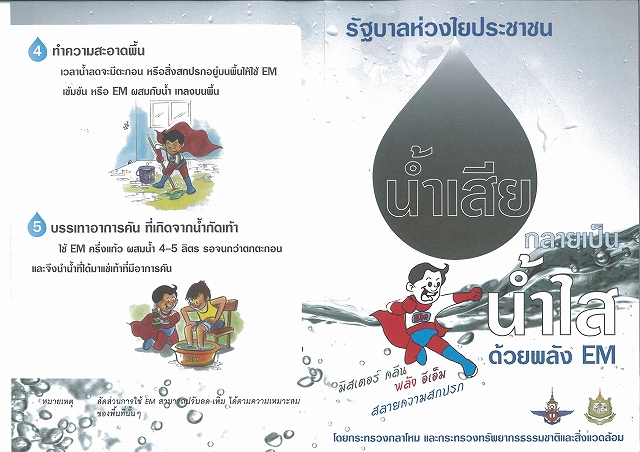
Picture 8
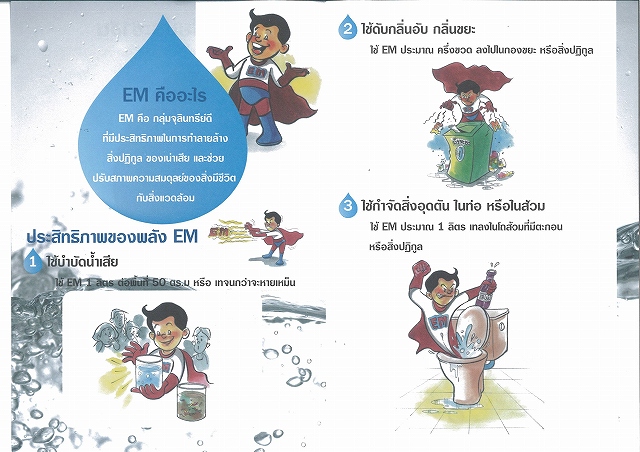
Picture 9
Picture 8-9: Front and back of the leaflet prepared and given out by the Ministry of Science, Technology, and Environment in order to explain how to use EM
n addition, the Federation of Economic Organizations of Thailand actively promoted EM to control hygienic problems; thereby, EM was applied in most of Japanese factories affected by the flood. The head of Buddhist Association of Thailand also appealed that he uses EM and prompted to drink EM to prevent communicable diseases. Consequently, no occurrence of hygienic problems and no spread of communicable diseases, to speak of, were observed. Thailand maneuvered safely through this disaster by EM application.
The results were reported throughout the world by mass media. Some Japanese commercial broadcasting stations also reported the results, but the public broadcasting station of Japan showed no interest. Although EMRO planned to provide EM for free of charge, Thailand insisted to pay because they are now economically independent and able to assume the cost.
EMRO's basic policy is that income from sale of EM is used for the benefit of the country where EM is sold. EMRO has a technical guidance agreement with the Ministry of Social Development and Human Security of Thailand. For the flood in Thailand, more than 200tons of EM were used to activate by 100 times to provide over 20,000tons of EMA, which was almost 10 times more than that was used in Northeastern Japan earthquake.
In case of Japan, no public office showed interest, and all EM disaster control works have been conducted by EM volunteers for free of charge. The control works in Fukushima prefecture by volunteers have been progressing steadily. EM station was set up over 20 locations in 2011. There will be additional stations in 2012.
EM was introduced to Thailand in 1986 when the shortage of rainfall in the northeastern part of the country in the preceding years had put the farming villages in danger. The introduction to Thailand was smooth without interference by academic organizations and/or public agencies, and accumulation of good results through practical experiences has earned trust in EM among Thai people. The success of EM use in Thailand has been followed by many Asian countries. In my next message, I like to talk about the history of how EM use was developed into the national policy of Thailand.
記事一覧へ
| 